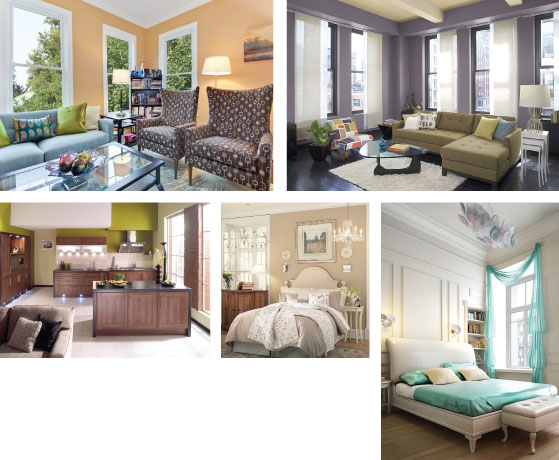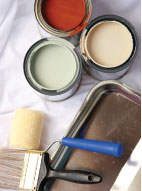We’ve all had moments when we picked up an interior design magazine and sighed over the beautiful pictures, wondering how simple colours can add magic to a room. Ankita Mamgain takes you over the essentials of painting interiors.
Colours are magical and tend to have their own mystical energy. They add drama, set mood and can affect your overall wellbeing. How welcoming or not a room, house or even an office is, is largely related to the play of hues in it. The good news is, this energy, if not desired, can be changed with the stroke of a brush.
Paint can make a statement with splashes of bold colour or it can be a soft backdrop to a more muted interior. Either way, painting is one of the easiest and least expensive tools in the interior design world that can truly add soul to any space.
The marketplace offers so many options of products, finishes, designs, textures, not to forget shades, that the sheer choice can be overwhelming and can even lead to some serious misjudgements. So it’s essential to start with a little homework on the subject, and that’s where, hopefully, we can help.
Preparation is Key
Seemingly easy, painting your home, especially if you already live in it, can be a daunting task. However with the right planning this process can be rendered completely hassle free.
• Assign a budget to the task and select your products accordingly. Then calculate the quantity of paint required
as per your needs.
• Choose a colour scheme for each room and make your selection of shades, patterns and textures. It’s always better to do a quick online search before you head out to meet a professional in this regard, then you will have some idea of what you are looking for.
• Once you decide on the mood you are seeking, go through the paint samples that fit your palette. Make sure to get samples from a few suppliers so you can see which ones give a greater variety of shades. Many companies, with their qualified consultants, can even help you achieve the right combination for each room before you spend anything on the supplies. So enquire if the paint company provides such services.
• When starting out with the job itself, remember it’s a lot easier to paint if nothing’s in your way; so empty the room out or at least as much as possible. When painting the living room, move large furniture pieces to the centre and cover with cloth or plastic.
• Clean before you start with the first coat of paint. You may not see it but there is build-up on the walls of dirt, dust and oils from your hands. Removing all this will allow the paint to adhere to the walls. Fill in any nail holes or cracks. You might also want to cover the floor with newspapers, or old cloth.
• Test the paint colour by buying a sample and painting a square on the wall. Allow it to dry and observe it in all lighting conditions.
• Another point to remember is the finish; it’s not just the colour alone that matters but the finish or sheen as well. High gloss paint finishes are durable and easier to clean, but highlight imperfections in your walls. Alternatively a flat paint finish will hide flaws but is more susceptible to damage. In most instances, an eggshell finish is the best option.

Each space has a unique personality
The idea may be to make each corner unique but remember to maintain an overall harmony of colour in the house unless the objective is to shock, in which case the sky’s the limit to your imagination.
In recent years, neutral colours have become a real trend in bedroom arrangement. Bright or matt shades of cream, beige and brown are very popular. They are a good choice for bedrooms especially because they can be successfully combined with almost any other colour. Other popular choices are softer shades of blue, lavender, green tones or even pink tones for children’s rooms if you want to create a relaxing and calm environment.
For living rooms you can go for something fun and fresh, combining earthy tones or creating drama with vibrant complementary hues. The kitchen is where a lot of action is, so keep in mind the durability of the paint type. Investing a few extra dinars here will really go a long way. As far as the colours are concerned white, grey, blue, red, yellow and green really shine. Each of these shades can do something different, but they all help create a warm and welcoming space.
Keep in mind that colours can also make a place look larger or smaller. Unifying a small area with one colour and blending the dimensions can visually magnify it a little. A popular choice for small spaces is white or its warm or cold variants as they reflect light and lead to the illusion of ‘no walls’ but many designers are currently opting for darker shades from the cooler palette such as blues and greens.
ASK THE EXPERTS
 The qualified technical team at Berger Paints can come to your rescue if you are finding it difficult to get started on your paint project. They recce the area and can offer bespoke solutions for your specific requirements. So whether you are living seaside or in a city condo, they help you zero down on not just the colour combinations but the type of paint, finishes and textures that’ll best suit your needs.
The qualified technical team at Berger Paints can come to your rescue if you are finding it difficult to get started on your paint project. They recce the area and can offer bespoke solutions for your specific requirements. So whether you are living seaside or in a city condo, they help you zero down on not just the colour combinations but the type of paint, finishes and textures that’ll best suit your needs.
The company recently introduced a new product called Crystal and is particularly proud of it. This unique water-based interior paint is stain resistant and 99.99 per cent anti-fungal making it a great choice for homes with small kids or even places such as restaurants and hospitals where high hygiene standards need to be maintained.


































